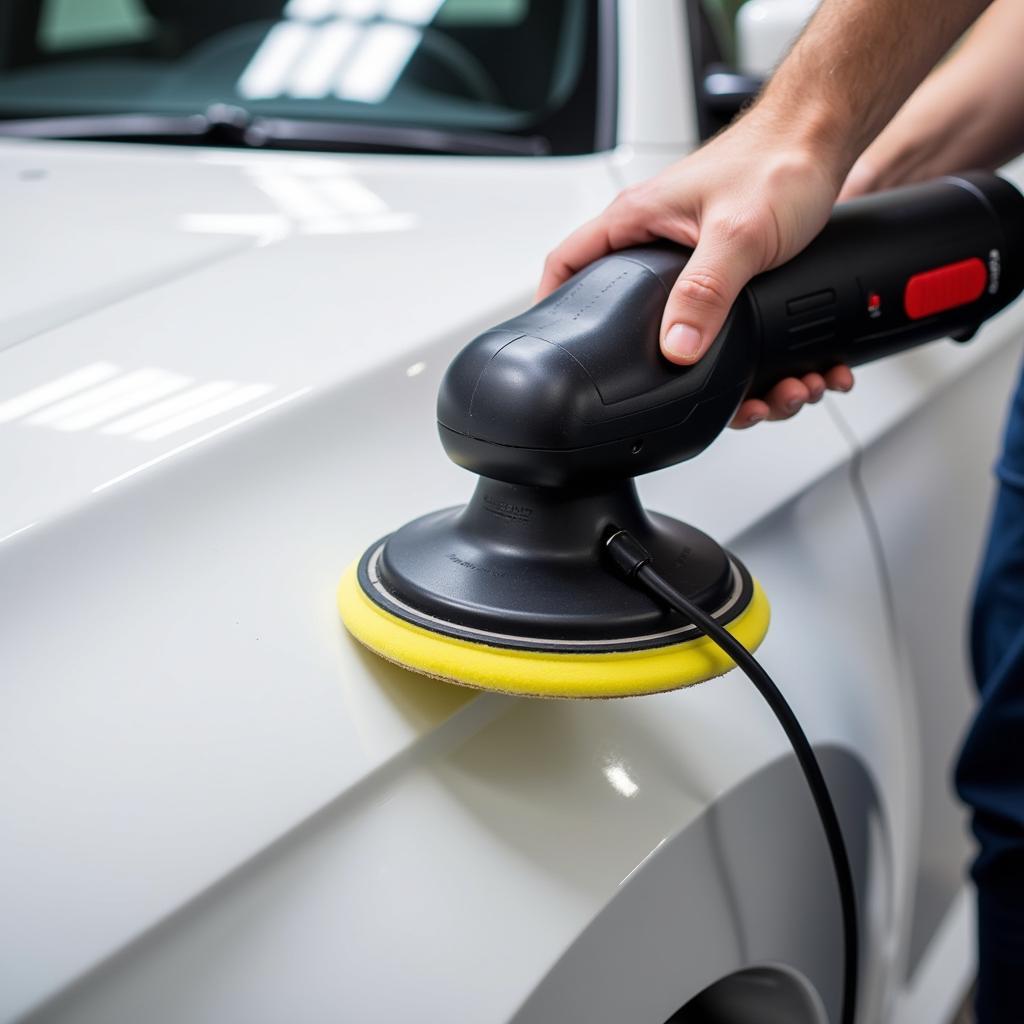Maintaining the pristine appearance of a new white car requires a dedicated detailing approach. White cars, while stunning, are notorious for showcasing dirt, swirl marks, and other imperfections. This comprehensive guide provides a step-by-step process on How To Detail A New White Car, ensuring it stays showroom-worthy for years to come.
Preparing Your White Car for Detailing
Before diving into the detailing process, proper preparation is essential. This involves gathering your supplies and ensuring your car is ready for the meticulous work ahead. You’ll need high-quality car wash soap, microfiber wash mitts, multiple buckets (one for wash, one for rinse), a pressure washer (optional but recommended), microfiber drying towels, clay bar and lubricant, various polishing and waxing products, and appropriate applicators and buffing pads. Park your car in a shaded area, away from direct sunlight, to prevent premature drying of cleaning solutions.
Similar to how to make your own car detailing products, understanding the ingredients and methods ensures the best results. This pre-detailing preparation sets the stage for a flawless finish.
Washing and Decontamination: The Foundation of Detailing
The initial step is a thorough wash to remove loose dirt and grime. Use the two-bucket method to minimize the risk of scratching the paint. Rinse your car thoroughly with the pressure washer or a strong stream of water. Next, the decontamination process is crucial, especially for white cars. A clay bar treatment will remove embedded contaminants like iron particles and tree sap that washing alone cannot remove. Lubricate the paint surface and gently glide the clay bar across it.
What’s the best way to wash a new white car? The two-bucket method is highly recommended to prevent cross-contamination and minimize swirl marks.
Polishing and Paint Correction
Polishing is where the magic happens. This step refines the paint, removing minor imperfections like swirl marks and light scratches, and restoring the paint’s clarity. Use a dual-action polisher with a suitable polishing pad and compound. White paint can be particularly susceptible to showing these imperfections, so careful polishing is essential. For deeper scratches, consider consulting a professional detailer.
does detailing a car remove scratches offers further insights into the effectiveness of detailing in scratch removal. This step is vital for achieving a flawless finish on a white car.
 Polishing White Car Paint with Dual-Action Polisher
Polishing White Car Paint with Dual-Action Polisher
Protecting Your White Car: Waxing or Sealing
After polishing, protecting the paint is paramount. Waxing or sealing provides a protective layer against environmental contaminants and UV rays. This not only preserves the paint’s shine but also makes future washing easier. Apply a high-quality wax or sealant using an applicator pad, working in small sections. Allow it to cure according to the manufacturer’s instructions, then buff off to reveal a dazzling shine.
Why is waxing or sealing important? It shields your car’s paint from harmful elements, maintaining its pristine condition for longer. Just as how to detail model car tires focuses on specific care, so too does protecting your white car’s paint require specialized attention.
Maintaining Your Detailed White Car
To maintain the results of your detailing efforts, regular washing and occasional top-up waxes are recommended. Avoid automated car washes and use the two-bucket method for best results. Drying your car immediately after washing will also prevent water spots.
Consider the advice of renowned detailing expert, Michael Phillips: “Regular maintenance washes are the key to preserving the results of a professional detail.” Another expert, Sarah Williams, adds: “Protecting your white car’s paint with a high-quality sealant is like giving it a suit of armor against the elements.”
Conclusion
Detailing a new white car requires a meticulous approach, but the results are rewarding. By following these steps and using quality products, you can keep your white car looking its best for years to come. Remember that regular maintenance is key to preserving the stunning finish you’ve achieved. How to detail a new white car effectively involves careful preparation, thorough washing, decontamination, polishing, protection, and consistent maintenance.
FAQ
- How often should I detail my white car? Every 3-6 months is generally recommended.
- Is it necessary to clay bar a new car? Yes, it removes contaminants that washing cannot.
- What type of wax is best for white cars? Synthetic sealants and carnauba waxes are excellent choices.
- Can I detail my white car in direct sunlight? No, it can cause premature drying of cleaning solutions.
- How can I prevent swirl marks on my white car? Use the two-bucket wash method and high-quality microfiber mitts.
- What is the best way to dry a white car? Use a high-quality microfiber drying towel and work in small sections.
- Should I use a pressure washer to wash my white car? Yes, but with caution and the correct nozzle to avoid damaging the paint.
If you need further assistance, contact us via WhatsApp: +1(641)206-8880 or Email: [email protected]. Our customer service team is available 24/7. We also have other helpful articles like how much do you tip your car detailer and what cuts better microfiber or foam when detailing a car.

Leave a Reply